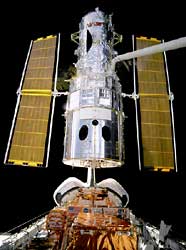|

Servicing
the Hubble Space Telescope
by
Jake Widman
Satellites
typically lead a lonely existence.
Once launched, they orbit in isolation until falling back
to earth. The Hubble Space Telescope is different—it
was made to be fixed in space. It has a modular design so
that space-walking astronauts can replace broken parts and
upgrade outdated systems. The HST's designers even put 76
handholds around it for the convenience of the astronauts
who would maintain it in space.

A
view inside the clean room.
|
The
original 1979 plans for an orbiting telescope called for
it to be brought down, serviced, and relaunched every five
years. Halfway between these major missions, astronauts
would service the telescope while it was still in orbit.
In 1985, however, concerns that the telescope might suffer
damage during regular returns to earth led NASA to decide
to perform all service in orbit, with "servicing missions"
scheduled to take place every three years.
There
have been three servicing missions since the Hubble was
placed in orbit in 1990. These updates and repairs have
left the telescope an even better scientific instrument
than it was at launch, the way putting new parts in a computer
can make it work better than it did to begin with.
The
first servicing mission, known as "SM1," was launched in
December 1993. Its main goal was to correct a serious flaw
in the telescope. Soon after it began operation, scientists
realized that something was wrong with the Hubble's primary
mirror: it had been made a tiny bit too flat. Though the
shape of the mirror was off by no more than a fraction of
the thickness of a human hair, the flaw was enough to make
it impossible to precisely focus all the light it gathered,
so the images sent back from the telescope were blurry.
The Corrective Optics Space Telescope Axial Replacement
(COSTAR) part of SM1 involved placing corrective mirrors—some
no bigger than a coin—at various places on the telescope.
These mirrors did the trick, enabling the HST to capture
the amazing images we've seen ever since.
There
were other tasks for SM1 as well. In addition to correcting
the defective mirror, astronauts also replaced parts of
the solar panel wings (still the largest structures ever
replaced in orbit), added processors to the flight computer,
added new sensors, and made a number of other enhancements.

Hubble
Space Telescope while docked to the Space Shuttle Discovery's
Payload Bay during the second servicing mission.
|
The
second mission—SM2—went up a little more than
three years later, in February 1997. This time, the task
was to add new instruments and perform general maintenance.
For instance, the astronauts added the Space Telescope Imaging
Spectrograph (STIS), which included ultraviolet detectors.
A spectrograph separates the gathered light into its component
colors, sort of the way a prism makes a rainbow. By examining
which colors are brightest, scientists can learn a lot about
the composition, temperature, and other qualities of the
source of the light. Today, information gathered by the
HST's spectrograph is helping researchers study black holes,
quasars, and star formation.
SM2
also brought up the Near Infrared Camera and Multi-Object
Spectrometer (NICMOS), which can record electromagnetic
waves in the near-infrared wavelength. The NICMOS sensors
have let scientists see objects that were too faint for
the HST's optical and ultraviolet sensors. The crew of SM2
also pioneered the use of space's first cordless power tool,
the Pistol Grip Tool, which would be used again two years
later.
Hubble's
next regular servicing mission was originally planned for
June 2000. However, since one of the telescope's six gyroscopes
(which control its aiming) failed in early 1999, the telescope
had only the minimum number needed to function properly.
NASA immediately began planning a special "call-up" mission,
SM3a, to replace the gyroscopes. As it turned out, the sense
of urgency was not misplaced, because a fourth gyroscope
failed in November 1999, sending the HST into a sort of
"sleep" mode—safe, but unable to make any observations.
When
the SM3a team went up in 1999, they replaced all six gyroscopes,
upgraded a guidance sensor and the spacecraft's computer,
and installed a voltage/temperature kit for the spacecraft's
batteries. A new transmitter, solid state recorder, and
thermal insulation blankets were also installed. As with
the other missions, the maintenance left the HST a better
instrument than it had been before.
The
second part of SM3—SM3b—is scheduled for the second
half of 2001. Its primary goal, as usual, is to upgrade
Hubble systems that might be weak or failing. One task,
for instance, will be to add a cooling unit for the NICMOS,
which has fallen out of service. Cooling the NICMOS sensors
will reduce electronic noise in its readings and enable
scientists to start using it again.
The
astronauts will install four new, more robust solar arrays
to generate power for the telescope. In addition, they will
make repairs to the deteriorating thermal insulation blanket
that surrounds the telescope and install a new camera (the
Advanced Camera for Surveys), replacing the Faint Object
Camera that had been used for general sky surveys. If necessary,
astronauts will also give the telescope a boost to keep
it in orbit, as was done in SM1 and SM2. Even at a height
of 360 miles (600 km), the HST is subject to atmospheric
drag that would eventually cause it to lose altitude and
make an unscheduled visit back home.

Read
more about
Hubble
servicing missions
.
Get
the lowdown on the
upcoming
servicing mission
, scheduled for November 2001.
|
![]()
![]()